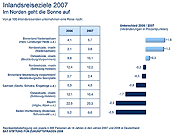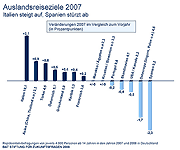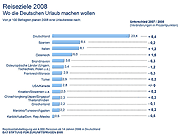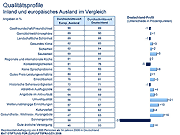Current research, 203
6 February 2008
BAT Foundation for Future Studies presents the 24th German Tourism Analysis
Pragmatism instead of panic: Germans still in a holiday mood. Crises and price slumps cannot curb the desire to travel
Neither the financial and stock market crisis nor the rising cost of energy and living can put the brakes on Germans„ desire to travel. Pragmatism rather than panic is the order of the day. The travel industry has finally overcome the shock of the century of “11 September 2001". Two thirds of Germans took a holiday trip lasting at least 5 days last year (65.0% - 2006: 64.7%). And when thinking about the coming travel season, Germans are in a holiday mood. Almost three quarters of the population (71%) want to go on holiday in 2008. This is according to the 24th German Tourism Analysis by the BAT Foundation for Future Studies, in which 4,000 Germans aged 14 and over were asked about their holiday behaviour in 2007 and their travel intentions for 2008.
„For most Germans, the economic upturn has at least reached their holiday budgets,“ says Prof Dr Horst W. Opaschowski, Scientific Director of the BAT Foundation. „The past travel season has quickly made us forget the problems of recent years, such as bird flu, terrorist attacks and the poor economy.“ Above all, the duration of trips is stabilising again. The dramatic decline in the average duration of holidays from 18.2 days (1980) to a low of 12.8 days in 2004 has come to a halt. German holidaymakers spent an average of 13.2 days travelling in 2007 (previous year 2006: 13.0 days). Opaschowski: „The trend towards ever shorter holidays is coming to an end. Holidaymakers want to stay longer again.“
Holidays in Germany remain popular.
Domestic travel regains market share
Germany remains the Germans' favourite holiday destination. One in three Germans (2005: 32% - 2006: 34% - 2007: 34%) spent their holidays in Germany last year. Domestic tourism is regaining the market share it had before the turn of the millennium (e.g. 1999: 35%). Social and demographic change in Germany is reinforcing this trend. Single people and senior citizens are over-represented when travelling domestically. The growing number of single-person households in Germany means that the group of people travelling alone is becoming ever larger. Single travellers are more interested in domestic trips than others (37.4%). This also applies to senior citizens who like to holiday in Germany (38.4%). But the self-employed and freelancers also recognise the value of domestic travel (35.0%).
„Instead of warmth, distance and vastness, people are now looking for proximity again,“ says Professor Opaschowski. „The German National Tourist Board's domestic marketing campaign ‚Kurz-nah-weg’ is starting to bear fruit. Many holiday regions in Germany no longer need to fear competition from sunny destinations.“ With the nationwide expansion of the wellness market segment, many domestic holiday regions have succeeded in developing into attractive year-round providers - regardless of the weather and season.
Domestic destinations 2007: The sun rises in the north.
Growing north-south divide
The past 2007 travel season, with a rather mixed summer, was a year with many bright and dark sides for domestic holiday regions. On the one hand, demand for domestic holidays was strong. On the other hand, the travel market was divided. The holiday regions on the North Sea and Baltic Sea maintained their leading positions or even strengthened them (e.g. in Mecklenburg-Western Pomerania). However, holiday destinations in the south lost considerable shares (e.g. in Bavaria, the Black Forest and Lake Constance). Professor Opaschowski on the results of the tourism analysis: „A growing north-south divide can be observed. The high in the north contrasts with significant market losses in the south. For the domestic travel balance in 2007, the sun is rising in the north.“
The southern holiday regions in Baden-Württemberg, from Lake Constance to the Black Forest, even lost a quarter of their market share, shrinking from 9.2 per cent (2006) to 6.6 per cent (2007). Bavaria also suffered losses last season (2006: 22.8% - 2007: 20.3%). Mountain and Alpine tourism is becoming less attractive to holidaymakers and is struggling to keep pace with the active holiday offers in the north in the form of sport and fitness, hiking and cycling, health and wellness offers.
By contrast, the holiday regions in Lower Saxony on the North Sea coast and on the North Sea islands (2006: 2.1% - 2007: 3.6%) and the Baltic Sea holiday regions in Mecklenburg-Western Pomerania (2006: 9.8% - 2007: 10.1%) recorded slight increases. Opaschowski: „Even rainy weather and falling cliffs have not affected the appeal of the regions from Rügen to Warnemünde.“ The competition for market share within Germany is no longer just about „north versus south“. The Baltic Sea regions are also competing with each other for the top position. Schleswig-Holstein is therefore increasingly feeling the competition from holiday providers in Mecklenburg-Vorpommern, which is why the Baltic Sea regions in Schleswig-Holstein attracted fewer holiday guests last season (2006: 12.1% - 2007: 10.4%). The North Sea and Baltic Sea will remain popular holiday destinations for Germans in the coming years. But in the battle for top positions and market share, the waves will be even higher. Local holiday quality - from pricing to service - will be the deciding factor.
The great success of the holiday regions in Lower Saxony last season speaks for the improvement in quality: from East Frisia to the Weserbergland, from the Harz Mountains to the Lüneburg Heath. These regions were able to significantly increase their market share (2006: 4.1% - 2007: 5.7%). More service and more infrastructure, remodelled castles and palaces as well as golf and wellness hotels in the Harz Mountains and in the Heath have contributed to this success.
Travelling abroad 2007.
Touristic trend reversal: Italy becomes the frontrunner.
Spain's dramatic fall from grace.
Over the past thirty years, more and more Germans have felt ready for a sun holiday in Spain: From Mallorca to Fuerteventura, from the Costa Brava to the Costa del Sol. Since then, Spain has been virtually programmed for double-digit growth rates. In 1999, one in six German holidaymakers (17%) stayed in Spain. However, since the turn of the millennium, Spanish tourism has stagnated and in the 2007 travel season experienced a historic slump not seen since 1980 (1980: 9.2% - 2007: 9.2%).
This tourist landslide, particularly on the Spanish mainland coasts and to a lesser extent on the Balearic and Canary Islands, has serious consequences: for the first time, Italy is once again the most popular destination for Germans, thus tying in with traditional German yearnings for Italy. Until the early 1980s, Italy was the most popular destination for Germans travelling abroad - in 1970, for example, it was more than twice as popular (12.0%) as Spain (5.0%). The turning point came around 1980 (Italy: 9.9% - Spain: 9.2%). Spain then pushed ahead, overtaking Italy and successfully maintaining its leading position until last year. Professor Opaschowski: „The trend reversal in tourism points to a renaissance of Italian tourism - from the classic educational trip between Rome, Florence and Pompeii to the former ‚Teutonic grill’ on the Adriatic and Riviera.“ One in ten German holidaymakers abroad (2007: 10.1% - in comparison: 2006: 8.0% - 2005: 7.7%) chose Italy as their holiday destination last year.
Compared to the previous year, Turkey, Austria and Greece also achieved growth. In addition to Spain, Eastern European destinations such as Hungary, Poland and the Czech Republic were less popular with German travellers last season (2006: 6.2% - 2007: 4.5%). Also noteworthy is the growing interest of German travellers in long-distance trips (2006: 2.4% - 2007: 3.3%) to China, Hong Kong, Japan, Singapore, Thailand and India. This is a growth area for tourism in the future.
Tourism forecast 2008.
Over two thirds want to go travelling.
The desire to travel remains unbroken
A representative sample of 4,000 people aged 14 and over throughout Germany were asked about their travel intentions for 2008. The results give the travel industry cause for optimism: Over two thirds of the population (70.8%) want to travel in 2008 or already have their suitcases packed. As in previous years, a good one in five Germans (21.7%) are unable or unwilling to travel this year. There is also a small proportion of those who are uncertain (7.5%), who do not yet know whether they will be able to afford a holiday trip for financial, time or professional reasons. For the vast majority of the population, however, their desire to travel remains unbroken. In 2008, Germans intend to remain true to their reputation as „world champion travellers“.
Destinations 2008.
Germany in demand. Asia on the upswing.
Eastern Europe on a downward trend
Almost one in four Germans (23.4%) with firm travel intentions want to go on holiday in their own country in 2008. Despite the variety and competition from foreign destinations, Germany remains the most popular holiday destination for Germans, which certainly includes city breaks from Berlin to Hamburg and Munich. However, the question of whether the north dominates or whether the south can catch up remains open. Opaschowski: „In domestic tourism - depending on the holiday region - anything is possible in 2008: for some a boom in bookings, for others a drop in sales, a record season or falling demand.“
2008 will also be a year of decision. Will Italy succeed in knocking Spain off the top spot for a long time? Or was the 2007 travel season an exceptional year? The travel intentions of Germans for 2008 indicate a close neck-and-neck race between Spain (8.4%) and Italy (8.1%). The downward trend in Eastern European destinations is also continuing in the travel intentions of Germans for 2008. Eastern Europe from Budapest to Prague is less in demand (-1.2 percentage points). Faraway destinations in Asia are still on the upswing, as they are evidently new destinations in line with the current trend.
Holiday in the test: Quality profiles of the holiday regions:
The tourism industry is increasingly responding to changing values: holiday quality is being redefined. The growing travel „experience“ has changed the quality expectations of holidaymakers. Quality is not only understood as a question of money. Rather, what is meant is a subjectively perceptible improvement in quality for everyone - according to the motto „Highest quality for every class and budget“. Quality in service, infrastructure and atmosphere: From the beautiful landscape to the clean beach to the cosy accommodation. Anyone selling holidays today has to offer more than just transport, accommodation and service.
The subject of the quality analysis were the holiday regions in Germany and abroad that were chosen as destinations by German holidaymakers in the past travel season. According to the results of the representative survey, the ten most important quality features from the point of view of the population are
- Hospitality
- Cosiness
- Beautiful landscape
- Healthy climate
- Security
- Cleanliness
- Good cuisine
- Contact options
- No language problems
- Coherent price-performance ratio.
These quality features have the greatest personal significance for the holiday experience. Environmental protection aspects such as „environmental quality“ are - once again - not favoured by holidaymakers and are of secondary importance.
Clean, safe and cosy.
The quality profile of German holiday regions
In the assessment of German holiday regions, holidaymakers rank atmosphere factors such as cosiness (89.7%) and hospitality (88.9%), cleanliness (87.8%) and safety (84.3%) above material offers such as adventure parks (68.9%), active holiday offers (69.2%) or cultural facilities (61.9%). These are the answers of German citizens to the question of which tourist quality features they „found“ on their last holiday trip. The answers reflect actual quality features and not ideal values or wishful thinking.
- Baltic Sea holidaymakers most emphasise the special atmosphere and cosiness (95.6%), the beautiful landscape (93.7%), the cleanliness (92.3%), the healthy climate (90.1%) and the attractive excursion options to leisure and adventure parks (75.6%). No other holiday region in Germany has higher approval ratings here.
- North Sea holidaymakers particularly emphasise the high environmental quality (88.9%), the good cuisine in the restaurants (82.6%), the active holiday options (77.7%) and weather-independent facilities such as bathing areas and shopping arcades (75.4%) These four features characterise the specific quality profile of the holiday regions on the North Sea.
- Those who holiday in Bavaria, from the Allgäu to the Alps, cite the hospitality (93.0%), the good value for money (87.3%), the good contact opportunities with locals and other travellers (81.9%) and the good accessibility of the Bavarian holiday regions (83.8%) as the most important features.
- Travellers to Baden-Württemberg feel particularly safe (91.9%) and praise the historical monuments and sights (79.8%).
The current holiday test enables the identification of specific strength profiles, but also allows conclusions to be drawn about existing weaknesses in the offer. Foundation Director Opaschowski: „A key word in the tourism industry is: holiday satisfaction. Holidaymakers want to return home satisfied with themselves and the world. That's why holidays simply ‚have to’ be enjoyable.“ Domestic holiday regions must make themselves independent of the weather by offering a variety of options and develop into attractive year-round holiday destinations. This is the only way to incentivise people to extend their stay, regardless of the weather and season.
Hospitality: Feel at home.
The quality profile of foreign holiday regions
Most foreign holiday destinations succeed in offering German travellers a ‚second home’ so that they can feel at home. In addition to the hospitable atmosphere, there is the contrasting beautiful landscape and nature that particularly fascinates holidaymakers abroad. And there is one quality feature that German holiday regions can only dream of - the guarantee of sunshine, such as in Italy (69.4%), Croatia and Slovenia (74.4%) or Spain (86.3%). Holidaymakers in Germany, on the other hand, only attest to a sun guarantee of 20.9 per cent for their domestic holiday region last year.
In terms of subjectively perceived holiday quality, individual holiday destinations are worlds apart. Germany, for example, is considered the cleanest holiday destination. Holidaymakers feel safest in Austria. Switzerland is considered to be the most environmentally friendly holiday destination. And hospitality is particularly at home in Greece. Nowhere is everything perfect. Holidaymakers know this and therefore choose destinations that are closest to their personal priorities.
Research information 24th German Tourism Analysis
Number and representation of respondents: 4,000 people aged 14 and over in Germany
Survey period: 02 to 31 January 2008
Survey institute: IPSOS Deutschland GmbH/Mölln
In addition to the current analyses and forecasts on travel behaviour in 2007/2008, the study also contains presentations on the key topic of „Quality profiles of holiday regions“.
See also directory of all publications






